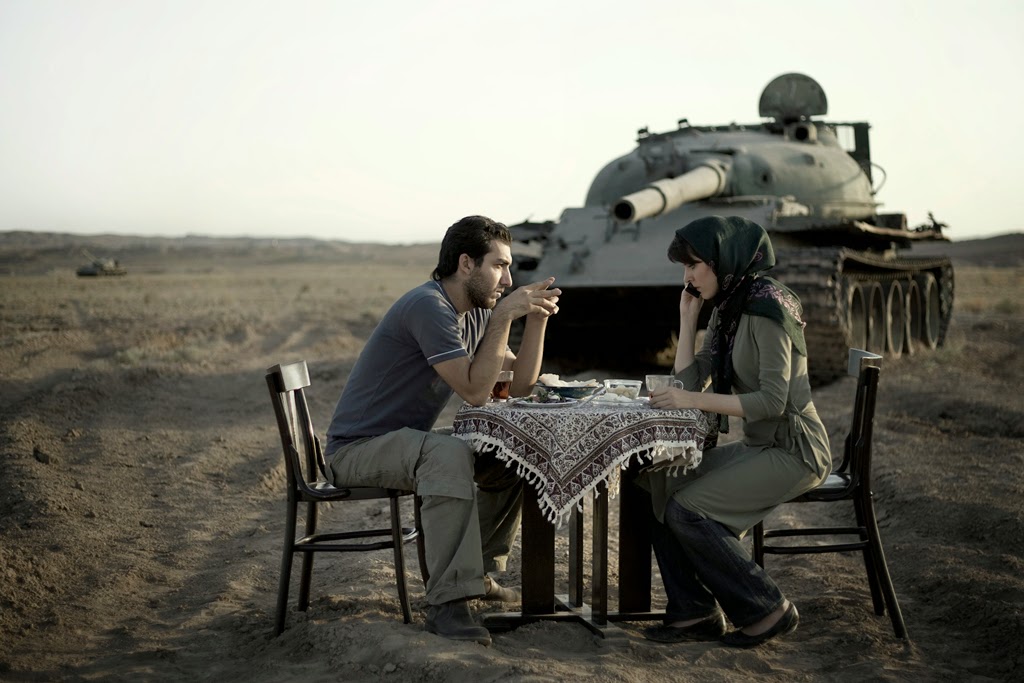at Ars Libri
 |
| A photograph from Gohar Dashti’s “Volcano” series, 2012. Courtesy Robert Klein Gallery and Boston Globe. |
Iranian photographer Gohar Dashti was born in 1980, in the midst of conflict. The Iranian Revolution had occurred the year before. The Iran-Iraq War began in 1980, and lasted eight years.
Dashti’s carefully constructed color photographs reflect the societal tensions she grew up with. Her show at Ars Libri, presented by Robert Klein Gallery and collector Azita Bina-Seibel, is filled with telling dissonances.
The title for Dashti’s “Volcano” series comes from the percolating threat of active and semi-active volcanoes in the region, which can be taken, too, as a metaphor for war. People laugh and enjoy life, but there’s something awry: The rough tail of a giant reptilian beast curls out from a hidden place, suggesting a sleeping giant.
One of the series takes place at an art gallery. A man and woman lean together in the center, giggling over a folded paper bird he holds. Others look to them, or gaze at the art, except for one man, wearing a red motorcycle helmet and facing away from everyone else. There, behind his feet, is the tail, lolling out a doorway. The beast is just in the next room.
For “Me, She, and the Others,” Dashti photographed individual women dressed for work, for home, and for a night out. Each image features all three shots, with the woman looking straight at us, without expression. The clothes do all the talking.
The work outfits are mostly black and gray, with headscarves. The social outfits vary more, but still they’re often dark, accentuated by scarves. But the home clothes, pictured in the center, cover a startling range. One woman wears a tube top and black jeans, with no scarf; another drapes herself in silky purple and pink shawls and scarves, still largely covered but much brighter than when she’s out in the world.
Dashti captures in her photographs the rich, sometimes tension-filled layers of Iranian society, in images filled with affection and foreboding.
Gohar Dashti Photographs from Volcano and Me, She and the Others. Closing date: April 30 2014.
 |
| Gohar Dashti, Today's Life and War, 2008. Courtesy Robert Klein Gallery. |
 |
| Gohar Dashti, Iran, Untitled, 2013. Courtesy Robert Klein Gallery. |
 |
| Gohar Dashti, Iran, Untitled, 2013. Courtesy Robert Klein Gallery. |
 |
| Gohar Dashti, Volcano, 2012. Courtesy Robert Klein Gallery. |
Small details
 |
| “Max” by Anne Harris. Courtesy Boston Globe. |
The show whizzes giddily from portraiture to landscape, from representation to abstraction, and it succeeds because such themes are always secondary to technique. David Palmquist’s lovely “Green Ranch House” rushes past in a slick, Gerhard Richter-like horizontal blur, except the details are utterly readable: the station wagon in the drive, the low roof, the cables arcing overhead; perhaps we feel even hungrier for those details because we’re only glimpsing them on a drive-by. A handful of Emily Eveleth’s sumptuous doughnuts, on small blocks of wood, exult in the sweet juiciness of paint.
Street artist Caleb Neelon offers a wonderfully cartoony canvas, “Insolationists,” in which he abstracts a stone tower into a spiky circle, populated hopefully with eggs, as an everyman with a bulbous nose and a red hat holds on for dear life, as stars twinkle behind him. Jordan Stabile paints hyper-real paintings of folded-open spiral notebooks, coolly precise.
On the abstract end of things, Lynda Schlosberg’s dizzyingly layered “Glacial Matrix” wheels with patterns of dots and stripes, streaming and dipping like a fishnet in a river.
Then there’s John Guthrie’s “Hotwax,” a flat X shape with broad limbs that slips off its axis at the middle. Each color on its own (browns, grays, a blue, a red) seems solid and strong, but together they appear furtive, as if they’re shy and holding back where they meet. Maybe the form’s near miss triggers that effect; the resulting tensions are loaded, like awkward silences at a family party.
Colonialism and identity
Thomas Young Gallery, an alternative space in South Boston, takes its name from a sign on the building of its previous digs on Broadway. Now in the Distillery artists’ building, the gallery reopens with “Inaugural Address,” for which director Gregory Maxim Burdett invited several artists to paint American Revolutionary Thomas Young, known for having refused to don Native American drag when he participated in the Boston Tea Party.
 |
| One of Raul Gonzalez III’s two versions of “Copy of Upon Viewing His Reflection.” Courtesy Boston Globe. |
Highlights include Raul Gonzalez III’s two versions of “Copy of Upon Viewing His Reflection,” showing Young looking distinctly uncomfortable as he tries on the red face and feathers, with a quote: “This isn’t working for me.”
In contrast, Pat Falco’s flat, graphic portrait of a bearded man in a red-patterned poncho appears ominous; he’s lean and hungry looking. Young is also credited with naming Vermont, and Jillian Evelyn’s “Vert Mont,” a cheeky take on Jay Ward Productions’ “Rocky and Bullwinkle” cartoon style, depicts Young with green hills behind him, finger raised, eyes closed, smug and smart as Ward’s genius dog, Peabody.
Via Boston Globe

No comments:
Post a Comment